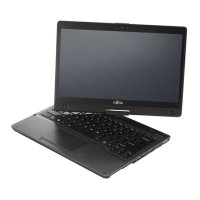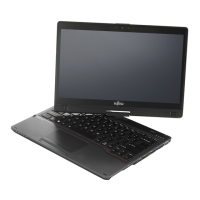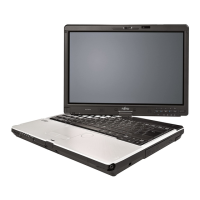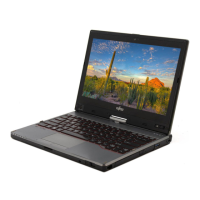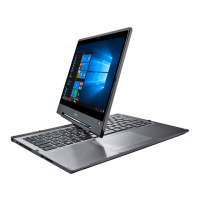
Do you have a question about the Fujitsu T936 and is the answer not in the manual?
| Operating System | Windows 10 Pro |
|---|---|
| Battery Life | Up to 12 hours |
| Display | 13.3 inches, 1920 x 1080 pixels |
| Storage | 256 GB SSD |
| Graphics | Intel HD Graphics 520 |
| Ports | HDMI |
| Connectivity | Wi-Fi 802.11ac, Bluetooth 4.1 |
| RAM Type | DDR4 |
| Processor | Intel Core i5 or i7 |
| CPU | Intel Core i5 or i7 |
FCC Part 15 compliance statement for the device.
Shows ports and indicators on the left side of the notebook.
Shows ports and indicators on the right side of the notebook.
Shows ports and indicators on the bottom of the notebook.
Essential safety information to follow when working with the notebook.
Safety precautions specific to devices with wireless components.
Tips and benefits of reducing power consumption for longer battery life.
Guidelines for safely transporting and using the notebook while traveling.
How to protect the notebook during transport, including security checks.
Recommended conditions and procedures for storing the notebook long-term.
Instructions and warnings for cleaning the notebook safely.
Steps for unpacking and inspecting the device for any damage.
Guidelines for selecting a suitable and safe location for setting up the device.
Instructions for connecting the AC adapter and power supply to the device.
Steps to power on the notebook for initial setup.
Guide to installing optional bonus applications after initial setup.
Covers status indicators, opening, switching on/off, and closing the notebook.
Explains switching between notebook and Tablet PC modes, and display orientation.
Details on using the stylus, clickpad, keyboard, tablet buttons, webcam, and memory cards.
Information on rechargeable battery, charging, maintenance, storage, and energy saving functions.
Covers SIM card, wireless components (LAN/Bluetooth/4G), Ethernet/LAN, and port replicator usage.
Summary of notebook security features like locks, passwords, and biometrics.
Setting up BIOS passwords, OS boot protection, and hard disk passwords.
Using fingerprint sensor, Smart Card reader, and tablet button security.
Information on enabling and disabling the TPM for enhanced security.
Connecting via HDMI, external monitors, and headphones.
Using USB ports for devices, charging, and safe removal.
Steps to access and start the BIOS Setup Utility.
How to navigate and use the BIOS Setup Utility interface.
Options for exiting the BIOS Setup Utility with or without saving changes.
Initial steps and advice for resolving notebook issues.
Resolving problems with LCD screen, external monitors, stylus, and keyboard.
Troubleshooting notebook unresponsiveness, wireless, printer, and battery issues.
Addressing battery drain, Smart Card reader, and BIOS error messages.
Provides detailed technical specifications for the notebook.
Detailed specifications for the Wireless LAN components.
Technical specifications for the optional port replicator.
Technical data for the notebook and port replicator AC adapters.
Information on proper disposal and recycling of the notebook and its components.
Safety instructions and cautions related to UL certification for the unit.
Information on the notebook's compliance with ENERGY STAR for energy efficiency.
Notes and statements regarding wireless LAN usage and compliance.
Official statements from FCC and Industry Canada regarding device operation.
Information on radio frequency exposure and export restrictions for the device.
Covers wireless LAN setup, modes, troubleshooting, and Bluetooth usage.
Procedures for backing up and recovering Windows 7 and Windows 10 systems.
Instructions for installing software after recovery and downloading driver updates.
